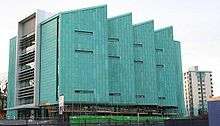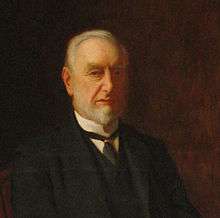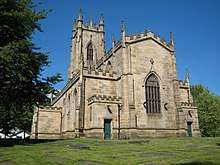University of Sheffield
The University of Sheffield (informally Sheffield University)[7][8] is a public research university in Sheffield, South Yorkshire, England. Its history traces back to the foundation of Sheffield Medical School in 1828, Firth College (1879) and Sheffield Technical School (1884).[1] Subsequently, it was named University College Sheffield in 1897 and gained royal charter as University of Sheffield in 1905.
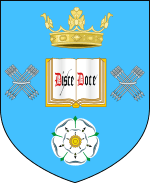 | ||||||||||||||
Former names | University College of Sheffield | |||||||||||||
|---|---|---|---|---|---|---|---|---|---|---|---|---|---|---|
| Motto | Latin: Rerum cognoscere causas | |||||||||||||
Motto in English | To discover the causes of things | |||||||||||||
| Type | Public research university | |||||||||||||
| Established | 1828 - Sheffield Medical School 1879 - Firth College 1884 - Sheffield Technical School[1] 1897 - University College of Sheffield[2] 1905 - University of Sheffield | |||||||||||||
| Endowment | £43.8 million (as of 31 July 2018)[3] | |||||||||||||
| Budget | £678.3 million (2017-18)[3] | |||||||||||||
| Chancellor | Lady Justice Rafferty | |||||||||||||
| Vice-Chancellor | Koen Lamberts[4] | |||||||||||||
Administrative staff | 6,581[5] | |||||||||||||
| Students | 30,195 (2018/19)[6] | |||||||||||||
| Undergraduates | 19,610 (2018/19)[6] | |||||||||||||
| Postgraduates | 10,585 (2018/19)[6] | |||||||||||||
| Location | , , England | |||||||||||||
| Campus | Urban | |||||||||||||
| Colours | Black & gold | |||||||||||||
| Affiliations | Russell Group WUN ACU N8 Group White Rose EQUIS AMBA Universities UK | |||||||||||||
| Website | www.sheffield.ac.uk | |||||||||||||
 | ||||||||||||||
Sheffield is a multi-campus university predominantly over two campus areas: the Western Bank and the St George's.[9] The university is organised into five academic faculties composed of multiple departments. It had 19,610 undergraduate and 10,585 postgraduate students in 2018/19. The annual income of the institution for 2017–18 was £678.3 million of which £196.8 million was from research grants and contracts, with an expenditure of £627.8 million.[3] Sheffield ranks among the top 10 of UK universities for research grant funding,[10] and it has become number one in the UK for income and investment in engineering research according to new data published by the Higher Education Statistics Agency (HESA).[11]
It is one of the original red brick universities, a member of the Russell Group of research-intensive universities, the Worldwide Universities Network, the N8 Group of the eight most research intensive universities in Northern England and the White Rose University Consortium. There are eight Nobel laureates affiliated with Sheffield and six of them are the alumni or former long-term staff of the university.[12]
History
Origins
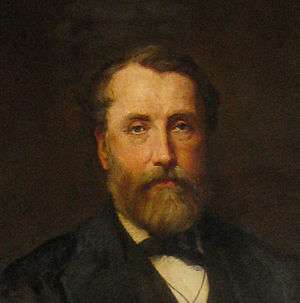
The University of Sheffield was originally formed by the merger of three colleges. The Sheffield School of Medicine was founded in 1828, followed in 1879[13] by the opening of Firth College, which developed out of the Cambridge University Extension Movement scheme, by Mark Firth, a steel manufacturer, to teach arts and science subjects.[14] Firth College then helped to fund the opening of the Sheffield Technical School in 1884 to teach applied science, the only major faculty the existing colleges did not cover. The Sheffield Technical School was founded because of local concern about the need for technical training, particularly steelmaking in Sheffield, and the school moved to St George's Square in 1886.[14] The three institutions merged in 1897 to form the University College of Sheffield by Royal Charter.[14] Sheffield was the only large city in England without a university. Steelworkers, coal miners, factory workers and the people of Sheffield donated over £50,000 in 1904 to help found the University of Sheffield.[15]
Royal charter

It was originally envisaged that the University College would join Manchester, Liverpool and Leeds as the fourth member of the federal Victoria University. However, the Victoria University began to split up as independent universities before this could happen and so the University College of Sheffield received its own Royal Charter on 31 May 1905 and became the University of Sheffield. In July 1905, Firth Court on Western Bank was opened by King Edward VII and Queen Alexandra. St George's Square remained the centre of departments of Applied Science, and the departments of Arts, Medicine and Science moved to Western Bank.[14] Sheffield is one of the six red brick universities, the civic universities founded in the major industrial cities of England.
Development since 1905
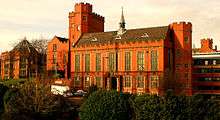
In 1905, there were 114 full-time students, and the first Hall of Residence (Stephenson Hall) and library (Edgar Allen library) had been established by then. The number of students increased to a short-lived peak of 1,000 in 1919. During the First World War, some of the academic subjects and courses were replaced by teaching of munitions making and medical appliances production.[14] Rather than from a single centre, the university has expanded since the 1920s from two ends, the Firth Court on Western Bank and the Sir Frederick Mappin Building on the St George's site.[9]
In 1943, the University Grants Committee announced that universities in the UK should look forward to expansion in the years after the Second World War.[9] Sheffield predicted a 50% increase in student population but the university was unprepared for such growth. There was pressure on the university to expand since the student numbers had increased from around 1,000 to 3,000 by 1946.[9] The university announced proposals for development in 1947, which emphasised the need for new departments, medical school, library, administration building, halls of residence, as well as the completion of the Western Bank Quadrangles and the extension of the Students' Union.[9]
The university then grew slowly until the 1950s and 1960s when it began to expand rapidly. Many new buildings (including the Main Library and the Arts Tower) were built and older houses were brought into academic use. Student numbers increased to their present levels of just under 26,000. At the same time in the 1950s, the university was expanding at other sites, including the St Georges area.[9] From the 1960s, many more buildings have been constructed or extended, including the Union of Students and St George's Library. The campus master plan proposed in the 1940s was completed by the 1970s, and the university required a new development plan.[9]

The 1980s saw the opening of many new buildings and centres, such as the multi-purpose Octagon Centre and the Sir Henry Stephenson Building. The university's teaching hospital, Northern General Hospital, was also extended.[9] In 1987 the University began to collaborate with its once would-be partners of the Victoria University by co-founding the Northern Consortium; a coalition for the education and recruitment of international students.[14]
1990s onwards
The university continued to expand in the 1990s. New premises were opened for School of the Clinical Dentistry, the Division of Education, and the Management School.[9] In 1995, the University took over the Sheffield and North Trent College of Nursing and Midwifery, the St. George's Hospital was extended and a new building at the Northern General Hospital has been constructed, which greatly increased the size of the medical faculty. In 2005, the South Yorkshire Strategic Health Authority announced that it would split the training between Sheffield and Sheffield Hallam University – however, the University decided to pull out of providing preregistration nursing and midwifery training due to "costs and operational difficulties".[16]
In the 21st century, the University opened many more major buildings, such as the Jessop Building, the Soundhouse, Jessop West and the Information Commons. The Arts Tower building, the Students' Union and University House buildings, the Sheffield Bioincubator and University Health Centre were also refurbished.[14] A new six-storey building, the Diamond, was opened on 28 September 2015.[17] In February 2016, the university started to work with Sheffield City Council to transform public spaces around the campus.[18] The £8 million project includes building and improving pedestrianisation, crossings, cycle routes, as well as greening the campus.[18][19]
Buildings and locations
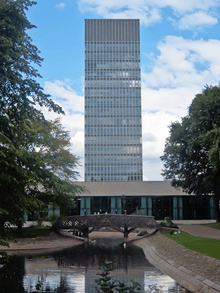
Main (Western Bank) campus
The University of Sheffield is not a campus university, though most of its buildings are located in fairly close proximity to each other. The centre of the University's presence lies one mile to the west of Sheffield city centre, where there is a mile-long collection of buildings belonging almost entirely to the University. This area includes the Sheffield Students' Union (housed next door to University House), the Octagon Centre, Firth Court, the Geography and Planning building, the Alfred Denny Building (housing natural sciences, the Departments of Animal and Plant Sciences and Biology, and including a small museum), the Dainton and Richard Roberts Buildings and the Hicks Building.
The Grade II*-listed library and Arts Tower are also located in this cluster.[20] A concourse under the main road (the A57) allows students to easily move between these buildings.
Amongst the more recent additions to the universities estate are The Information Commons, opened in 2007, The Soundhouse (2008) and the Jessop West building (2009), the first UK project by renowned Berlin architects Sauerbruch Hutton.[21] In addition, throughout 2010 the Western Bank Library received a £3.3 million restoration and refurbishment, the University of Sheffield Union of Students underwent a £5 million rebuild, and work commenced on a multimillion-pound refurbishment of the grade II* listed Arts Tower to extend its lifespan by 30 years.[22]
Octagon Centre
The Octagon Centre is a multi-purpose conference centre and music venue situated at the Western Bank campus, and is joined by a skyway to University House. The Octagon Centre comprises an eight-sided auditorium with a capacity of 1,600, offices, meeting rooms, and a lounge with bar and patio.[23] The Octagon Centre consists of a main auditorium known as the Convocation Hall, with offices and meeting rooms in corridors across two floors at a lower elevation on the southern side of the building, and a bar lounge. All of these areas are connected by a foyer entrance block. The building is connected to University House by a footbridge, offering access to University House's catering facilities.
Firth Court and Alfred Denny Building
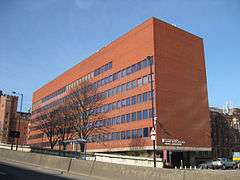
Firth Court is the main administrative centre for the University of Sheffield, stands at the heart of the University precinct on Western Bank. It originally housed the Arts, Science and Medicine departments, while it is currently home to the Department for Molecular Biology and Biotechnology and Biomedical Science. The building was opened by King Edward VII and Queen Alexandra in 1905, and is named after Mark Firth.[14]
The Rotunda, located to the left of Firth Court, is the Registrar and Secretary's Office.[24] It was formerly the Edgar Allen Library, opened 26 April 1909 by Prince and Princess of Wales.[25]
Alfred Denny Building, a red brick building named after the first Professor of Zoology at the department, is linked to Firth Court via the Addison Building. The building houses the Biomedical Science, Animal and Plant Science Departments including its associated museum, Disability and Dyslexia Support Service, and the Perak Laboratories.[26]
Dainton and Richard Roberts Buildings
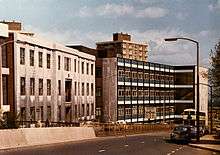
The Dainton Building, houses the Department of Chemistry and Faculty of Sciences, is named after Sheffield academic chemist and university chancellor Frederick Sydney Dainton. The East Wing of Dainton Building was renamed Richard Roberts Building after Nobel Laureate and University graduate Richard Roberts.
Hicks Building
The Hicks Building is a building named after William Mitchinson Hicks, a British mathematician and physicist who spent most of his career at Sheffield, contributing to the development of the university. It houses the departments of Physics and Astronomy, the Chemistry and Physics Workshop and the School of Mathematics and Statistics. The Building is in three sections, including a taller building clad in red-brick, a shorter fully linked section clad in blue tiles and glass, and a section facing the University Concourse.
Arts Tower and Western Bank Library
The Arts Tower is a Grade II* listed building opened in 1966.[1] It was the tallest structure in Sheffield from 1965 to 2010, and is the tallest university building in the UK.[27] The building, previously housed several academic departments, is now mainly an administration block and has the architecture department in it. The Arts Tower houses one of Europe's few surviving examples of a paternoster lift.[28]
A bridge at the mezzanine level links the tower to the Western Bank Library. The two buildings are intended to be viewed together.[29] Formerly known as the University Library, the Western Bank Library was the main library of the University of Sheffield until the Information Commons was established. The Grade II*-listed library is home to 25,000 rare books and 150 special collections.[30]
St George's Campus
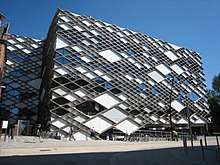
To the east lies St George's Campus, named after St George's Church (now a lecture theatre and postgraduate residence). The campus is centred on Mappin Street, the location of the Faculty of Engineering (partly housed in the Grade II-listed Mappin Building) and the Department of Journalism Studies, Department of Economics and Department of Computer Science. The University also maintains the Turner Museum of Glass in this area. The University has converted the listed Victorian Jessop Hospital for Women into the new home of the Department of Music.
The formerly grade II listed Edwardian wing of the Jessop Hospital was replaced by a new £81 million building for the Faculty of Engineering which opened in September 2015, named The Diamond. It houses lecture theatres, laboratories, workrooms and other facilities for the teaching of engineering.[31][32]
Sir Frederick Mappin Building
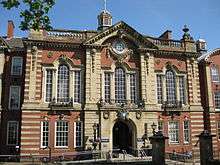
The Sir Frederick Mappin Building is a grade II-listed building in an area known as the St George's Complex. The building houses much of the Faculty of Engineering and St George's IT centre.[27] The oldest part of the building, the former Technical School, now lies in the centre of the building. The extensive Mappin Street frontage includes the main entrance, the John Carr Library and Mappin Hall, and is connected to the Technical School by a bridge.
St George's Church
St George's Church is a building built in the Perpendicular style. It was the first of three commissioners' churches to be built in Sheffield under the Church Building Act 1818. The church closed in 1981 and was acquired by the University. It was converted for use as a lecture theatre in 1994.,[33] while the upstairs has been converted for use as student accommodation.
West of the main campus
Further west lies Weston Park, the Weston Park Museum, the Harold Cantor Gallery, sports facilities in the Crookesmoor area, and the Faculty of Medicine, Dentistry and Health around the Royal Hallamshire Hospital (although these subjects are taught in the city's extensive teaching hospitals under the Sheffield Teaching Hospitals NHS Foundation Trust, and throughout South Yorkshire and North East Lincolnshire). It is in this area that the new £12 million Sheffield Institute for Translational Neuroscience (SITraN), opened by Her Majesty Queen Elizabeth II in November 2010, is located.[34]
Bartolomé House
Bartolomé House is a set of grade II-listed buildings on Winter Street, Sheffield, which house the School of Law at the University of Sheffield. Originally constructed in 1881 as the Winter Street Hospital for Infectious Diseases, it became a dedicated tuberculosis hospital in 1912, and was later the St George's Hospital for geriatric patients, which closed in 1990. After refurbishment it became the School of Nursing for the University of Sheffield in 1997.[35] It was named Bartolomé House in 1998 after Dr Mariano Martin de Bartolomé, who was President of the Sheffield Medical School for 22 years in the 19th century.[36] In 2008 it was taken over by the School of Law.[37]
It was designed by S. L. Swann in Gothic Revival style in red brick with ashlar dressings and slate roofs.[38]
 General view from the Arts Tower
General view from the Arts Tower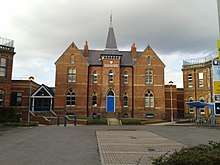 Bartolomé House centre building
Bartolomé House centre building Bartolomé House lodge
Bartolomé House lodge Bartolomé House South East wing
Bartolomé House South East wing
Libraries and museums
The University has currently four libraries: the Information Commons, Western Bank Library, Health Sciences Libraries (Royal Hallamshire Hospital and Northern General Hospital), and The Diamond.[39] The University of Sheffield Library is a member of Research Libraries UK.[40]
The Western Bank Library has an Exhibition Gallery.[41] The Gallery space enables collections from the University Library and the National Fairground Archive to be displayed in controlled conditions.[42]
The Alfred Denny Museum is a museum operated by the University.[43] It was established in 1905, and was located in Firth Court then moved to Alfred Denny Building.[44] The Museum has specimens from all major phyla, and two letters written from Charles Darwin to Henry Denny. Many of the specimens have been collected since the 1900s, but much of the information about the collection was lost during the Second World War.[45]
The Turner Museum of Glass houses the University's collections of 19th and 20th century glass.[46] It contains items mainly from major European and American glassworkers and examples from ancient Egypt and Rome. It is in the Hadfield Building. It was founded by W E S Turner[46][47] of the University in 1943. One of the exhibits is the wedding dress of Helen Nairn (Turner's wife) which is made of glass fibre. This has been selected as one of the items in the BBC's A History of the World in 100 Objects.[48]
The Traditional Heritage Museum (THM) was part of the National Centre for English Cultural Tradition opened to the public in 1985.[49] It was created by Prof Widdowson in 1964 and was run by volunteers and students.[50] The THM housed collections including a replica kitchen from the 1920s, reconstructed workshops and retail shops, such as Pollard's tea and coffee.[49] The University decided to close the Museum in 2011 because the building could not afford continued public access.[49][51]
Manvers campus
The Manvers campus, at Wath-on-Dearne between Rotherham and Barnsley, was where the majority of nursing was taught, but this has now been mothballed.
Gallery

- University Arms
- Broad Lane Court
 Bartolomé House, Sheffield Law School
Bartolomé House, Sheffield Law School
Organisation
Faculties and departments
The University has five faculties plus an International Faculty in Thessaloniki, Greece.[52]
|
|
School of Architecture
The Sheffield School of Architecture is one of the longest established architecture schools in the UK, opening in 1908, and was located in the tower of Firth Court. It was soon moved to the Sunday School in Shearwood Road and is located on the top 6 floors of the Arts Tower since 1965.[53]
The School has courses accredited by the Architects Registration Board (ARB) and the Royal Institute of British Architects (RIBA), and has an active student society (SUAS). In the Research Excellence Framework (REF) 2014, Sheffield School of Architecture ranked 4th in the UK.[54]
Management School
Established in 1986, Sheffield University Management School is an AMBA, AACSB and EQUIS accredited business school. It is one of 60 business schools in the world to have achieved triple accreditation.[55]
In 2013 the school moved into newly refurbished facilities close to the University of Sheffield campus and Broomhill. It now has dedicated learning and teaching space, a courtyard, dedicated café and Employability Hub.[56]
Medical School
Sheffield Medical School was founded in 1828. It operated independently as the Sheffield School of Medicine until its mergers with Firth College in 1879 and with Sheffield Technical School in 1884.[57]
The Medical School is one of 32 bodies entitled by the General Medical Council (GMC) to award medical degrees in the United Kingdom. The GMC is the body responsible for registering doctors to practise medicine as well as regulating medical education and training in the United Kingdom.[58]
Governance
There are several bodies which govern the University, including the University Executive Board, the Court, the Council and the Senate.
The University Executive Board, whose members are: Vice-Chancellor, five Faculty Pro-Vice-Chancellors, two Institutional Pro-Vice-Chancellors (Research and Innovation, and Learning and Teaching), Registrar and Secretary, chief financial officer (CFO), and Director of Human Resources.
The Court is a large body which fosters relations between the University and the community, and includes lay members, many of whom are University alumni. Ex-officio members of the Court include all the MPs of Sheffield, the Bishops of Sheffield and Hallam, and the Chief Constable of South Yorkshire Police.[59] It also includes representatives of professional bodies such as the Arts Council, Royal Society and the General Medical Council.[60] Court meets annually to receive reports from the Council, the Senate and the Students' Union. It serves many official functions including Chancellor election.
The Council manages the University's business side (finance and property).[59] Council membership comprises a majority of non-executive lay members. The chair and deputy chair hold the title Pro-Chancellor and currently are Tony Pedder and Sarah Harkness.[61] The Senate manages the academic side of the University. It is the highest academic authority of the University, and is chaired by the Vice-Chancellor. It is also responsible for the regulation of the students' discipline.[59]
Vice-Chancellors
- 1905: Charles Eliot
- 1913: Herbert Fisher
- 1917: William Ripper (acting)
- 1919: William Henry Hadow
- 1930: Sir Arthur Pickard-Cambridge
- 1938: Irvine Masson
- 1953: John Macnaghten Whittaker
- 1965: Arthur Roy Clapham (acting)
- 1966: Hugh Robson
- 1974: Geoffrey Sims
- 1991: Gareth Roberts
- 2001: Bob Boucher
- 2007: Sir Keith Burnett
- 2018: Koen Lamberts
Finances
The university's annual income for 2014–15 was £560.6 million of which £144.1 million was from research grants and contracts, with an expenditure of £539.3 million resulting in a surplus of £21.3 million. Its endowment was £39.0 million.[62]
Coat of arms
The arms of the University blazoned Azure, A gold-edged book inscribed with the Latin Disce Doce (Learn and Teach), A sheaf of eight silver arrows on either side (from the arms of the city), The Crown of Success and The White Rose of York, with a scroll carrying the motto Rerum cognoscere causas (To Discover the Causes of Things; from Virgil's Georgics II, 490), which was also the motto of Firth College.[63] The University's logo, consists of a redrawn version of the Coat of Arms and the name of the institution, is introduced in 2005, the centenary year of the University. However, the Coat of Arms remains the official heraldic symbol of the University, and should not be confused with the logo.[63]
Branding
The brand (encompassing the visual identity) is centred on the theme of "discovery", led by the Latin motto from the coat of arms "Rerum Cognoscere Causas" – "to discover the causes of things". It has been applied across print, screen and other areas such as signage, vehicle livery and merchandising. The project was key to the University's Marketing Department receiving "HEIST Marketing Team of the Year, 2005".[64]
The University's fonts are Stephenson and Blake. Both serif font Stephenson and sans serif font Blake are modified versions of a typeface designed by Sheffield company Stephenson & Blake Co.[65][66]
Academic profile
Reputation and rankings
| National rankings | |
|---|---|
| Complete (2021)[67] | 28 |
| Guardian (2020)[68] | 39 |
| Times / Sunday Times (2020)[69] | 25 |
| Global rankings | |
| ARWU (2019)[70] | 101–150 |
| CWTS Leiden (2019)[71] | 131 |
| QS (2020)[72] | 75= |
| THE (2020)[73] | 106 |
| British Government assessment | |
| Teaching Excellence Framework[74] | Silver |
The university has been described by The Times as one of the powerhouses of British higher education.[75] The university is a member of the Russell Group, the European University Association, the Worldwide Universities Network and the White Rose University Consortium.[76][77][78] Meanwhile, it was among the top 10 of the Russell Group for research output and top 12 for research strength in Research Excellence Framework 2014.[79] In terms of research citations, Sheffield was ranked 93rd worldwide and 9th in the UK by the CWUR 2018-19.[80] It was also ranked 20th overall in Europe and 10th in the UK for number of signed EU grant agreements according to the data since 2007.[81]
Sheffield has won Queen's Anniversary Prizes in 1998, 2000, 2002 and 2007.[82] In 2011 it was named 'University of the Year' in the Times Higher Education awards.[83] The latest Times Higher Education Student Experience Survey 2014 ranked the University of Sheffield 1st for student experience, social life, university facilities and accommodation, among other categories. It was also named as one of the top 50 most international universities in 2018 around the world[84] and its reputation of outstanding teaching has been underlined in the most recent league table which put Sheffield joint 9th in the UK and 11th across Europe.[85]
In the 2014 Research Excellence Framework (REF) Sheffield was ranked 12th for research power[86] and 14th by GPA for research quality in the UK,[87] with 86% (8th highest among the Russell Group) of the research submitted by the academic staff having been rigorously judged as world leading (4*) or internationally excellent (3*).[88] The University was one of only eleven in the country to make 30 or more submissions in a wide range of subject areas. Of the 35 submissions from Sheffield, 23 were judged to be in the top ten in the Russell Group for the quality of their research outputs.
Admissions
| 2017 | 2016 | 2015 | 2014 | 2013 | |
|---|---|---|---|---|---|
| Applications[89] | 34,605 | 35,200 | 35,300 | 36,820 | 35,565 |
| Offer Rate (%)[90] | 84.0 | 84.6 | 85.6 | 84.1 | 82.6 |
| Enrols[91] | 5,545 | 5,985 | 5,790 | 5,560 | 5,425 |
| Yield (%) | 19.1 | 20.1 | 19.2 | 18.0 | 18.5 |
| Applicant/Enrolled Ratio | 6.24 | 5.88 | 6.10 | 6.62 | 6.56 |
| Average Entry Tariff[92][lower-alpha 1] | n/a | 156 | 407 | 415 | 427 |
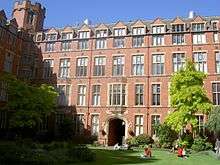
In terms of average UCAS points of entrants, Sheffield ranked 29th in Britain in 2014.[93] The university gives offers of admission to 85.6% of its applicants, the 4th highest amongst the Russell Group.[94]
According to the 2017 Times and Sunday Times Good University Guide, approximately 13% of Sheffield's undergraduates come from independent schools.[95] In the 2016-17 academic year, the university had a domicile breakdown of 71:5:24 of UK:EU:non-EU students respectively with a female to male ratio of 51:49.[96]
Research partners
Major research partners and clients include Boeing, Rolls Royce, Siemens, Unilever, Boots, AstraZeneca, GSK, ICI, and Slazenger, as well as UK and overseas government agencies and charitable foundations.[97]
The university also works with local small and medium enterprises through the dedicated physical spaces at the Sheffield Bioincubator and Kroto Innovation Centre.[98][99]
For many years the University has been engaged in theological publishing through Sheffield Academic Press and JSOT Press.
The university is a partner organisation in Higher Futures, a collaborative association of institutions set up under the government's Lifelong Learning Networks initiative, to co-ordinate vocational and work-based education.[100]
As well as the research carried out in departments, the university has over 180 specialised research centres or institutes.[101] The last Teaching Quality Assessment awarded Sheffield University grades of "excellent" in 29 subject areas, a record equalled by only a few other UK universities.[102]
Involvement with the arms trade
The University of Sheffield's Advanced Manufacturing Research Centre is run in partnership with Boeing, which conducts research projects funded by arms manufacturers such as BAE Systems.[103] In 2008, the University partnered with BAE Systems to launch a new Centre for Research in Active Control which aimed to improve the stealth of BAE Systems' submarines.[104] In 2012 the Students Union voted in favour of the University ending all links with the arms trade.[105]
Student life
Students' Union
The University of Sheffield Students' Union was founded in 1906 and has nearly three hundred student societies and nearly fifty sports teams. The Students' Union has been voted best in the UK for ten consecutive years by the Times Higher Education Student Experience Survey.[106]
Sheffield University Football Club has been established for many decades and has previously competed in the FA Amateur Cup and FA Vase. The Union building contains society and union workplaces and coffee shops, restaurants, shops, and the student run cinema Film Unit. Facilities include two bars (Bar One – which has a book-able function room with its own bar, The Raynor Lounge – and The Interval); a three-room club venue (Foundry); There is also a student radio station called Forge Radio, a TV station called Forge TV, and a newspaper called Forge Press, which are run under the umbrella of 'Forge Media'.
In November 2009 a development project began to redevelop the Students' Union building, funded by £5 million by the HEFCE, which was completed and re-opened in September 2010. Works centred on improving circulation around the building by aligning previously disjointed floors, improving internal access between the Union building and neighbouring University House, and constructing a new entrance and lobby that incorporates the university's traditional colours of black and gold. During 2012–13 the Students' Union went under a further redevelopment costing £20 million which led to the refurbishment of the University House. University House, which was one of the first glass curtain walled buildings in the world when it was completed in 1963, has now been integrated with the University's Students' Union in one single building.[107]
Student accommodation
The University halls of residence comprises two separate sites: Ranmoor/Endcliffe, and City.[108]
Off campus can be found Sheffield Student Housing Co-operative, a student housing cooperative providing not-for-profit, student-managed housing for its members. They currently manage a property on Northfield Road in Crookes, Sheffield.
Varsity sports
The annual Sheffield Varsity takes place between teams from the University and its rival Sheffield Hallam University starting from 1996.[109] Varsity is divided into winter and summer competitions.[109] The University has 26 varsity sports (sports contested in varsity). The University sports colours are black and gold. The University of Sheffield won the Varsity competition in 2013, beating Sheffield Hallam University for the first time in ten years.[110] It extended the new found winning streak to six years in a row; winning again from 2014 to 2018.[111][112][113]
People associated with the university
Notable alumni and academics
 David Blunkett, MP and former Home Secretary
David Blunkett, MP and former Home Secretary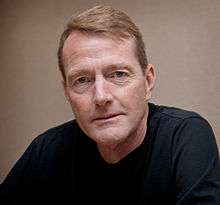 Lee Child, author
Lee Child, author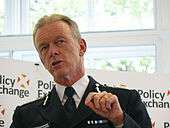 Sir Bernard Hogan-Howe, Commissioner of the Metropolitan Police Service
Sir Bernard Hogan-Howe, Commissioner of the Metropolitan Police Service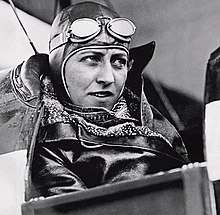 Amy Johnson, aviation pioneer
Amy Johnson, aviation pioneer Jessica Ennis, Olympic Gold medallist, heptathlete
Jessica Ennis, Olympic Gold medallist, heptathlete- Andy Haldane, Chief Economist at the Bank of England
Nobel prizes
The University's Faculty of Science is associated with six Nobel laureates, two for the Department of Molecular Biology and Biotechnology:
- 1945 Nobel Prize in Physiology or Medicine (joint award) Howard Florey, for his work on penicillin[114]
- 1953 Nobel Prize in Physiology or Medicine, Hans Adolf Krebs, "for the discovery of the citric acid cycle in cellular respiration"[115]
And four to its Department of Chemistry:
- 1967 Nobel Prize in Chemistry (joint award), George Porter, "for their work on extremely fast chemical reactions" (see Flash photolysis)[116]
- 1993 Nobel Prize in Physiology or Medicine (joint award), Richard J. Roberts, "for the discovery that genes in eukaryotes are not contiguous strings but contain introns, and that the splicing of messenger RNA to delete those introns can occur in different ways, yielding different proteins from the same DNA sequence"[117]
- 1996 Nobel Prize in Chemistry (joint award), Sir Harry Kroto, "for their discovery of fullerenes"[118]
- 2016 Nobel Prize in Chemistry (joint award), Sir James Fraser Stoddart, "for the design and synthesis of molecular machines"[119]

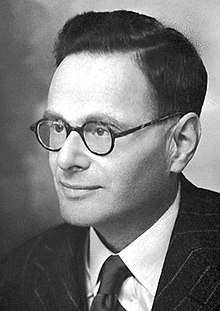
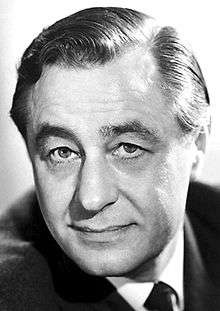
.jpg)

Harold Kroto .jpg)
References in popular culture
A fictionalized version of the University of Sheffield is the setting of the award-winning comic book series, Giant Days.
References
- New UCAS Tariff system from 2016
- Mathers, Helen (2005). Steel City Scholars, The Centenary History of the University of Sheffield. James and James. p. 191. ISBN 1-904022-01-4.
- https://www.sheffield.ac.uk/polopoly_fs/1.52606!/file/royal_charter.pdf
- "Financial Statements for the Year to 31 July 2018" (PDF). University of Sheffield. p. 54. Retrieved 2 December 2018.
- Blackledge, Richard (26 June 2018). "Sheffield University appoints new vice-chancellor". The Star. Retrieved 6 December 2018.
- "Financial Statements for the Year to 31 July 2017" (PDF). University of Sheffield. p. 54. Retrieved 22 December 2017.
- "Where do HE students study?". Higher Education Statistics Agency. Retrieved 1 March 2020.
- "MAJOR SPACE DISCOVERY: Sheffield University helps unlock new wonders of the universe". The Star. JPI Media. Retrieved 23 February 2016.
- "Mobile phones are 'cooking' men's sperm". The Telegraph. Telegraph Media Group. Retrieved 23 February 2016.
- "The Campus in Context" (PDF). University of Sheffield. Retrieved 3 February 2016.
- "Oxford tops research grant table for third year". 16 November 2017.
- https://www.sheffield.ac.uk/news/nr/engineering-research-number-one-universities-uk-best-study-collaborate-1.845379
- "Nobel Prize winners associated with the University". University of Sheffield. Retrieved 23 February 2016.
- "A Legacy of Excellence" (PDF). Retrieved 22 November 2013.
- "Historical note". University of Sheffield. Retrieved 8 September 2015.
- "Graduation 2013" (PDF). Retrieved 12 March 2015.
- Donald MacLeod (20 July 2005). "Sheffield pulls out of nurse training deal". The Guardian. London. Retrieved 4 April 2008.
- "Our new £81m Diamond building opens its doors for students". Estates & Facilities Management. University of Sheffield. Retrieved 4 February 2016.
- "Transforming our public spaces". Campus Masterplan. University of Sheffield. Retrieved 4 February 2016.
- "Improving our key spaces". Campus Masterplan. University of Sheffield. Retrieved 4 February 2016.
- "Campus map". University of Sheffield. Retrieved 24 June 2015.
- "About Jessop". The University of Sheffield. 2010. Archived from the original on 14 September 2009. Retrieved 6 December 2010.
- "Arts Tower Project". The University of Sheffield. 23 November 2010. Archived from the original on 1 November 2009. Retrieved 6 December 2010.
- "Octagon". University of Sheffield. Retrieved 24 June 2015.
- "University of Sheffield Map". University of Sheffield. 2015. Retrieved 13 February 2015.
- "University of Sheffield and Edgar Allen Library". Picture Sheffield. 2015. Retrieved 13 February 2015.
- "Department of Animal and Plant Sciences". University of Sheffield. Archived from the original on 13 September 2015. Retrieved 24 June 2015.
- "Campus landmarks". University of Sheffield. Retrieved 24 June 2015.
- "PatList". Retrieved 16 July 2015.
- Harman, R. & Minnis, J. (2004) Pevsner City Guides: Sheffield, pp82–84. New Haven & London: Yale University Press. ISBN 0-300-10585-1
- Historic England (1993). "Library and Arts Tower, University of Sheffield (1247655)". National Heritage List for England. Retrieved 7 January 2006.(registration required)
- "University opens new £81m new Diamond building". The Star (Sheffield). 29 September 2015.
- "New Engineering Building will open door to growth and investment". The University of Sheffield. 17 December 2012. Retrieved 16 August 2013.
- Harman, R. & Minnis, J. (2004) Pevsner City Guides: Sheffield, p88. New Haven & London: Yale University Press. ISBN 0-300-10585-1
- "SITraN". The University of Sheffield. 18 November 2010. Retrieved 6 December 2010.
- Mathers, Helen (2005). Steel City Scholars – The Centenary History of the University of Sheffield. London: James & James. pp. 339–40. ISBN 1904022014.
- Mathers, Helen (2005). Steel City Scholars – The Centenary History of the University of Sheffield. London: James & James. p. 27. ISBN 1904022014.
- "Your University" (PDF). www.sheffield.ac.uk. University of Sheffield. 2008. Retrieved 3 November 2017.
- Historic England. "Central Block at St George's Hospital (1067336)". National Heritage List for England. Retrieved 3 November 2017.
- "The University Library". The University of Sheffield. Retrieved 26 February 2015.
- "About the Library". The University of Sheffield. Retrieved 26 February 2015.
- "Exhibition Gallery". The University of Sheffield. Retrieved 26 February 2015.
- "WBL Exhibition" (PDF). The University of Sheffield. Retrieved 26 February 2015.
- "The Alfred Denny Museum of Zoology". The University of Sheffield. Retrieved 26 February 2015.
- "History of Alfred Denny Museum". The University of Sheffield. Retrieved 26 February 2015.
- "The Sheffield Jungle". The University of Sheffield. Archived from the original on 25 February 2013. Retrieved 26 February 2015.
- "About the Museum". The University of Sheffield. Retrieved 27 February 2015.
- "W E S Turner". Science and Society. Retrieved 27 February 2015.
- BBC A History of the World Glass Fibre Wedding Dress
- "The Traditional Heritage Museum". The University of Sheffield. Retrieved 5 March 2015.
- "Founder of Traditional Heritage Museum says site could close for good". The Star. Retrieved 5 March 2015.
- "Sheffield Traditional Heritage Museum shuts permanently". BBC. Retrieved 5 March 2015.
- "Faculties". The University of Sheffield. Retrieved 16 June 2010.
- "The History of the Sheffield School of Architecture". The University of Sheffield. Retrieved 14 February 2015.
- "REF 2014 Results". The University of Sheffield. Archived from the original on 23 December 2014. Retrieved 14 February 2015.
- "Accredited MBM Programmes | Association of MBAs". Media.mbaworld.com. 1 January 1970. Retrieved 28 March 2011.
- "Management School". The University of Sheffield. Retrieved 14 February 2015.
- University of Sheffield. "Historical note". shef.ac.uk/about/history. Retrieved 28 March 2018.
- "www.gmc-uk.org General Medical Council". gmc-uk.org. Retrieved 1 August 2010.
- "Governance of the University". The University of Sheffield. Archived from the original on 23 June 2009.
- "Membership of the Court" (PDF). The University of Sheffield. 1 August 2009. Archived from the original (PDF) on 26 March 2010. Retrieved 2 August 2010.
- Sheffield, University of. "Membership of the Council - Council - Governance - The University of Sheffield". www.sheffield.ac.uk.
- "Financial Statements for the Year to 31 July 2016" (PDF). University of Sheffield. p. 54. Retrieved 21 December 2016.
- "The Arms of the University of Sheffield". University of Sheffield. Retrieved 3 September 2015.
- "University scoops top marketing award". The University of Sheffield. 5 April 2006. Retrieved 29 December 2007.
- "Stephenson and Blake fonts". The University of Sheffield. Archived from the original on 2 April 2015. Retrieved 5 March 2015.
- "Visual Identity". The University of Sheffield. Archived from the original on 2 April 2015. Retrieved 5 March 2015.
- "University League Table 2021". The Complete University Guide. 1 June 2020.
- "University league tables 2020". The Guardian. 7 June 2019.
- "The Times and Sunday Times University Good University Guide 2020". Times Newspapers.
- "Academic Ranking of World Universities 2019". Shanghai Ranking Consultancy.
- "CWTS Leiden Ranking 2019 - PP top 10%". CWTS Leiden Ranking 2019.
- "QS World University Rankings 2020". Quacquarelli Symonds Ltd.
- "World University Rankings 2020". Times Higher Education.
- "Teaching Excellence Framework outcomes". Higher Education Funding Council for England.
- Asthana, Anushka (23 September 2007). "University of Sheffield". The Times. London. Retrieved 19 December 2007.
- "WUN Member Universities".
- "N8 Research Partnership".
- "White Rose University Consortium About Us".
- "Research". www.sheffield.ac.uk.
- https://cwur.org/2018-19/united-kingdom.php
- https://www.sheffield.ac.uk/research/impact/eu
- University website Archived 27 November 2007 at the Wayback Machine Queen's Anniversary Prizes
- "Sheffield named 'University of the Year' at annual THE Awards". Times Higher Education. 25 November 2011.
- "Most international universities in the world 2018: top 200". 14 March 2018.
- "THE Europe Teaching Rankings 2018: developing continental standards". 11 July 2018.
- "University Research Excellence Framework 2014 – the full rankings". 17 December 2014 – via The Guardian.
- https://www.timeshighereducation.com/sites/default/files/Attachments/2014/12/17/k/a/s/over-14-01.pdf
- Sheffield, University of. "REF 2014 confirms Sheffield as a world-leading university - News releases - News - The University of Sheffield". www.sheffield.ac.uk.
- "End of Cycle 2017 Data Resources DR4_001_03 Applications by provider". UCAS. UCAS. 2017. Retrieved 25 January 2018.
- "Sex, area background and ethnic group: S18 University of Sheffield". UCAS. UCAS. 2017. Retrieved 25 January 2018.
- "End of Cycle 2017 Data Resources DR4_001_02 Main scheme acceptances by provider". UCAS. UCAS. 2017. Retrieved 25 January 2018.
- "Top UK University League Table and Rankings". Complete University Guide.
- "University League Table 2017". Complete University Guide. Retrieved 15 June 2016.
- "Which elite universities have the highest offer rates". The Telegraph. Retrieved 21 October 2016.
- "The Times and Sunday Times Good University Guide 2017". The Good University Guide. London. Retrieved 16 August 2016.(subscription required)
- "Where do HE students study?". hesa.ac.uk. Higher Education Statistics Authority. Retrieved 9 February 2018.
- Sheffield, University of. "Partnerships with companies - Partners and collaborators - For business - The University of Sheffield". www.sheffield.ac.uk. Archived from the original on 15 April 2017. Retrieved 6 June 2017.
- "Our Centres". University of Sheffield Innovation. Archived from the original on 3 March 2016. Retrieved 23 February 2016.
- "Facilities". Research & Innovation Services. The University of Sheffield. Archived from the original on 4 March 2016. Retrieved 23 February 2016.
- "Partners". Higher Futures. Retrieved 30 July 2007.
- Sheffield, University of. "Research - The University of Sheffield". www.sheffield.ac.uk.
- "A global reputation". The University of Sheffield. Retrieved 23 February 2016.
- "About AMRC". AMRC. Retrieved 16 August 2013.
- "BAE SYSTEMS Centre for Research in Active Control launched – news releases – News – ACSE". The University of Sheffield. Archived from the original on 6 July 2013. Retrieved 16 August 2013.
- Rouse, Alisha (18 October 2012). "'Fund Education Not War' proposal voted in, as record turnout chooses new union councillors". Forge Press. University of Sheffield Students Union. Archived from the original on 21 August 2014.
- Sheffield, University of. "THE Student Experience Survey: Students vote University of Sheffield's Students' Union best nationally for tenth year running - Latest - News - The University of Sheffield". www.sheffield.ac.uk. Retrieved 11 February 2019.
- University of Sheffield. "Award-winning Students' Union launches today following multimillion pound refurbishment". Retrieved 16 July 2015.
- "Accommodation Locations". Archived from the original on 1 October 2013. Retrieved 26 March 2015.
- "Sheffield Varsity 2012". Archived from the original on 2 April 2015. Retrieved 31 March 2015.
- University of Sheffield. "Varsity victory for University of Sheffield's sporting champions". Retrieved 16 July 2015.
- "Archived copy". Archived from the original on 15 November 2014. Retrieved 23 April 2015.CS1 maint: archived copy as title (link)
- "Crowned the Varsity champions for a third year running". Retrieved 16 July 2015.
- "Sheffield Varsity 2018". sheffieldvarsity.com.
- "Sir Howard Florey". Nobel Media. Retrieved 24 June 2015.
- "Hans Krebs". Nobel Media. Retrieved 24 June 2015.
- "George Porter". Nobel Media. Retrieved 24 June 2015.
- "Richard J. Roberts". Nobel Media. Archived from the original on 4 March 2016. Retrieved 24 June 2015.
- "Sir Harry Kroto". Nobel Media. Retrieved 24 June 2015.
- "Press Release: The Nobel Prize in Chemistry 2016". Nobel Media. Retrieved 6 October 2016.
Further reading
There are two official histories of the university:
- Arthur W. Chapman (1955) The Story of a Modern University: A History of the University of Sheffield, Oxford University Press.
- Helen Mathers (2005) Steel City Scholars: The Centenary History of the University of Sheffield, London: James & James.
External links
| Wikimedia Commons has media related to University of Sheffield. |
